Zhichao Lu
Department of Computer Science, City University of Hong Kong
ASBench: Image Anomalies Synthesis Benchmark for Anomaly Detection
Oct 09, 2025Abstract:Anomaly detection plays a pivotal role in manufacturing quality control, yet its application is constrained by limited abnormal samples and high manual annotation costs. While anomaly synthesis offers a promising solution, existing studies predominantly treat anomaly synthesis as an auxiliary component within anomaly detection frameworks, lacking systematic evaluation of anomaly synthesis algorithms. Current research also overlook crucial factors specific to anomaly synthesis, such as decoupling its impact from detection, quantitative analysis of synthetic data and adaptability across different scenarios. To address these limitations, we propose ASBench, the first comprehensive benchmarking framework dedicated to evaluating anomaly synthesis methods. Our framework introduces four critical evaluation dimensions: (i) the generalization performance across different datasets and pipelines (ii) the ratio of synthetic to real data (iii) the correlation between intrinsic metrics of synthesis images and anomaly detection performance metrics , and (iv) strategies for hybrid anomaly synthesis methods. Through extensive experiments, ASBench not only reveals limitations in current anomaly synthesis methods but also provides actionable insights for future research directions in anomaly synthesis
SpikingMamba: Towards Energy-Efficient Large Language Models via Knowledge Distillation from Mamba
Oct 06, 2025
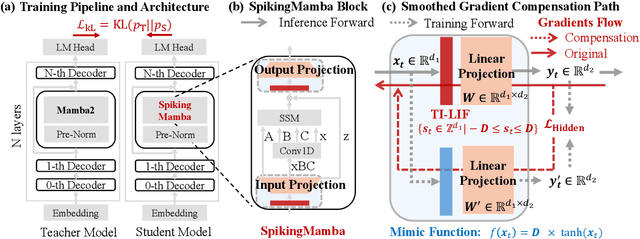


Abstract:Large Language Models (LLMs) have achieved remarkable performance across tasks but remain energy-intensive due to dense matrix operations. Spiking neural networks (SNNs) improve energy efficiency by replacing dense matrix multiplications with sparse accumulations. Their sparse spike activity enables efficient LLMs deployment on edge devices. However, prior SNN-based LLMs often sacrifice performance for efficiency, and recovering accuracy typically requires full pretraining, which is costly and impractical. To address this, we propose SpikingMamba, an energy-efficient SNN-based LLMs distilled from Mamba that improves energy efficiency with minimal accuracy sacrifice. SpikingMamba integrates two key components: (a) TI-LIF, a ternary-integer spiking neuron that preserves semantic polarity through signed multi-level spike representations. (b) A training-exclusive Smoothed Gradient Compensation (SGC) path mitigating quantization loss while preserving spike-driven efficiency. We employ a single-stage distillation strategy to transfer the zero-shot ability of pretrained Mamba and further enhance it via reinforcement learning (RL). Experiments show that SpikingMamba-1.3B achieves a 4.76$\times$ energy benefit, with only a 4.78\% zero-shot accuracy gap compared to the original Mamba, and achieves a further 2.55\% accuracy improvement after RL.
Functional Consistency of LLM Code Embeddings: A Self-Evolving Data Synthesis Framework for Benchmarking
Aug 27, 2025Abstract:Embedding models have demonstrated strong performance in tasks like clustering, retrieval, and feature extraction while offering computational advantages over generative models and cross-encoders. Benchmarks such as MTEB have shown that text embeddings from large language models (LLMs) capture rich semantic information, but their ability to reflect code-level functional semantics remains unclear. Existing studies largely focus on code clone detection, which emphasizes syntactic similarity and overlooks functional understanding. In this paper, we focus on the functional consistency of LLM code embeddings, which determines if two code snippets perform the same function regardless of syntactic differences. We propose a novel data synthesis framework called Functionality-Oriented Code Self-Evolution to construct diverse and challenging benchmarks. Specifically, we define code examples across four semantic and syntactic categories and find that existing datasets predominantly capture syntactic properties. Our framework generates four unique variations from a single code instance, providing a broader spectrum of code examples that better reflect functional differences. Extensive experiments on three downstream tasks-code clone detection, code functional consistency identification, and code retrieval-demonstrate that embedding models significantly improve their performance when trained on our evolved datasets. These results highlight the effectiveness and generalization of our data synthesis framework, advancing the functional understanding of code.
Quantization Meets dLLMs: A Systematic Study of Post-training Quantization for Diffusion LLMs
Aug 20, 2025Abstract:Recent advances in diffusion large language models (dLLMs) have introduced a promising alternative to autoregressive (AR) LLMs for natural language generation tasks, leveraging full attention and denoising-based decoding strategies. However, the deployment of these models on edge devices remains challenging due to their massive parameter scale and high resource demands. While post-training quantization (PTQ) has emerged as a widely adopted technique for compressing AR LLMs, its applicability to dLLMs remains largely unexplored. In this work, we present the first systematic study on quantizing diffusion-based language models. We begin by identifying the presence of activation outliers, characterized by abnormally large activation values that dominate the dynamic range. These outliers pose a key challenge to low-bit quantization, as they make it difficult to preserve precision for the majority of values. More importantly, we implement state-of-the-art PTQ methods and conduct a comprehensive evaluation across multiple task types and model variants. Our analysis is structured along four key dimensions: bit-width, quantization method, task category, and model type. Through this multi-perspective evaluation, we offer practical insights into the quantization behavior of dLLMs under different configurations. We hope our findings provide a foundation for future research in efficient dLLM deployment. All codes and experimental setups will be released to support the community.
Discovering Interpretable Programmatic Policies via Multimodal LLM-assisted Evolutionary Search
Aug 07, 2025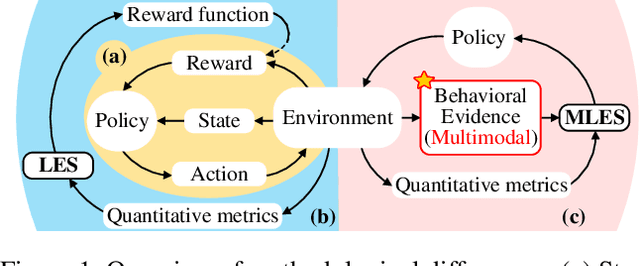
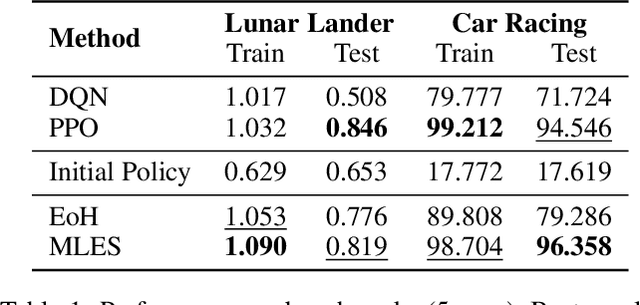
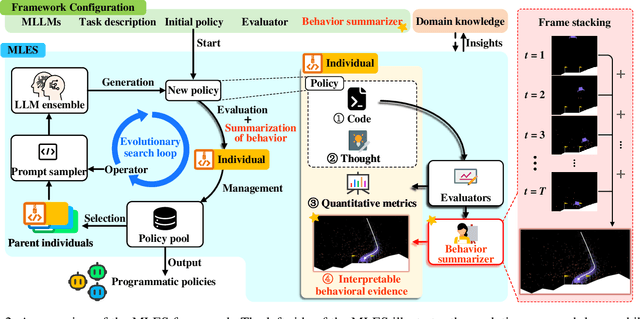
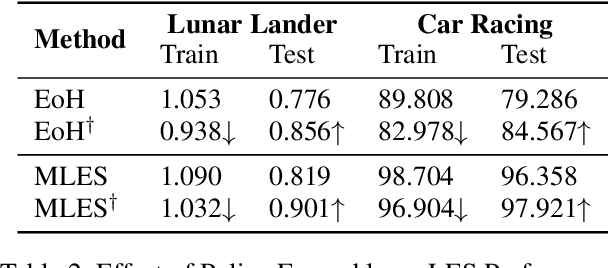
Abstract:Interpretability and high performance are essential goals in designing control policies, particularly for safety-critical tasks. Deep reinforcement learning has greatly enhanced performance, yet its inherent lack of interpretability often undermines trust and hinders real-world deployment. This work addresses these dual challenges by introducing a novel approach for programmatic policy discovery, called Multimodal Large Language Model-assisted Evolutionary Search (MLES). MLES utilizes multimodal large language models as policy generators, combining them with evolutionary mechanisms for automatic policy optimization. It integrates visual feedback-driven behavior analysis within the policy generation process to identify failure patterns and facilitate targeted improvements, enhancing the efficiency of policy discovery and producing adaptable, human-aligned policies. Experimental results show that MLES achieves policy discovery capabilities and efficiency comparable to Proximal Policy Optimization (PPO) across two control tasks, while offering transparent control logic and traceable design processes. This paradigm overcomes the limitations of predefined domain-specific languages, facilitates knowledge transfer and reuse, and is scalable across various control tasks. MLES shows promise as a leading approach for the next generation of interpretable control policy discovery.
Trade-offs in Image Generation: How Do Different Dimensions Interact?
Jul 29, 2025Abstract:Model performance in text-to-image (T2I) and image-to-image (I2I) generation often depends on multiple aspects, including quality, alignment, diversity, and robustness. However, models' complex trade-offs among these dimensions have rarely been explored due to (1) the lack of datasets that allow fine-grained quantification of these trade-offs, and (2) the use of a single metric for multiple dimensions. To bridge this gap, we introduce TRIG-Bench (Trade-offs in Image Generation), which spans 10 dimensions (Realism, Originality, Aesthetics, Content, Relation, Style, Knowledge, Ambiguity, Toxicity, and Bias), contains 40,200 samples, and covers 132 pairwise dimensional subsets. Furthermore, we develop TRIGScore, a VLM-as-judge metric that automatically adapts to various dimensions. Based on TRIG-Bench and TRIGScore, we evaluate 14 models across T2I and I2I tasks. In addition, we propose the Relation Recognition System to generate the Dimension Trade-off Map (DTM) that visualizes the trade-offs among model-specific capabilities. Our experiments demonstrate that DTM consistently provides a comprehensive understanding of the trade-offs between dimensions for each type of generative model. Notably, we show that the model's dimension-specific weaknesses can be mitigated through fine-tuning on DTM to enhance overall performance. Code is available at: https://github.com/fesvhtr/TRIG
TokLIP: Marry Visual Tokens to CLIP for Multimodal Comprehension and Generation
May 08, 2025Abstract:Pioneering token-based works such as Chameleon and Emu3 have established a foundation for multimodal unification but face challenges of high training computational overhead and limited comprehension performance due to a lack of high-level semantics. In this paper, we introduce TokLIP, a visual tokenizer that enhances comprehension by semanticizing vector-quantized (VQ) tokens and incorporating CLIP-level semantics while enabling end-to-end multimodal autoregressive training with standard VQ tokens. TokLIP integrates a low-level discrete VQ tokenizer with a ViT-based token encoder to capture high-level continuous semantics. Unlike previous approaches (e.g., VILA-U) that discretize high-level features, TokLIP disentangles training objectives for comprehension and generation, allowing the direct application of advanced VQ tokenizers without the need for tailored quantization operations. Our empirical results demonstrate that TokLIP achieves exceptional data efficiency, empowering visual tokens with high-level semantic understanding while enhancing low-level generative capacity, making it well-suited for autoregressive Transformers in both comprehension and generation tasks. The code and models are available at https://github.com/TencentARC/TokLIP.
Learning from Loss Landscape: Generalizable Mixed-Precision Quantization via Adaptive Sharpness-Aware Gradient Aligning
May 08, 2025Abstract:Mixed Precision Quantization (MPQ) has become an essential technique for optimizing neural network by determining the optimal bitwidth per layer. Existing MPQ methods, however, face a major hurdle: they require a computationally expensive search for quantization policies on large-scale datasets. To resolve this issue, we introduce a novel approach that first searches for quantization policies on small datasets and then generalizes them to large-scale datasets. This approach simplifies the process, eliminating the need for large-scale quantization fine-tuning and only necessitating model weight adjustment. Our method is characterized by three key techniques: sharpness-aware minimization for enhanced quantization generalization, implicit gradient direction alignment to handle gradient conflicts among different optimization objectives, and an adaptive perturbation radius to accelerate optimization. Both theoretical analysis and experimental results validate our approach. Using the CIFAR10 dataset (just 0.5\% the size of ImageNet training data) for MPQ policy search, we achieved equivalent accuracy on ImageNet with a significantly lower computational cost, while improving efficiency by up to 150% over the baselines.
A Survey on Industrial Anomalies Synthesis
Feb 23, 2025Abstract:This paper comprehensively reviews anomaly synthesis methodologies. Existing surveys focus on limited techniques, missing an overall field view and understanding method interconnections. In contrast, our study offers a unified review, covering about 40 representative methods across Hand-crafted, Distribution-hypothesis-based, Generative models (GM)-based, and Vision-language models (VLM)-based synthesis. We introduce the first industrial anomaly synthesis (IAS) taxonomy. Prior works lack formal classification or use simplistic taxonomies, hampering structured comparisons and trend identification. Our taxonomy provides a fine-grained framework reflecting methodological progress and practical implications, grounding future research. Furthermore, we explore cross-modality synthesis and large-scale VLM. Previous surveys overlooked multimodal data and VLM in anomaly synthesis, limiting insights into their advantages. Our survey analyzes their integration, benefits, challenges, and prospects, offering a roadmap to boost IAS with multimodal learning. More resources are available at https://github.com/M-3LAB/awesome-anomaly-synthesis.
MOS-Attack: A Scalable Multi-objective Adversarial Attack Framework
Jan 13, 2025Abstract:Crafting adversarial examples is crucial for evaluating and enhancing the robustness of Deep Neural Networks (DNNs), presenting a challenge equivalent to maximizing a non-differentiable 0-1 loss function. However, existing single objective methods, namely adversarial attacks focus on a surrogate loss function, do not fully harness the benefits of engaging multiple loss functions, as a result of insufficient understanding of their synergistic and conflicting nature. To overcome these limitations, we propose the Multi-Objective Set-based Attack (MOS Attack), a novel adversarial attack framework leveraging multiple loss functions and automatically uncovering their interrelations. The MOS Attack adopts a set-based multi-objective optimization strategy, enabling the incorporation of numerous loss functions without additional parameters. It also automatically mines synergistic patterns among various losses, facilitating the generation of potent adversarial attacks with fewer objectives. Extensive experiments have shown that our MOS Attack outperforms single-objective attacks. Furthermore, by harnessing the identified synergistic patterns, MOS Attack continues to show superior results with a reduced number of loss functions.
 Add to Chrome
Add to Chrome Add to Firefox
Add to Firefox Add to Edge
Add to Edge